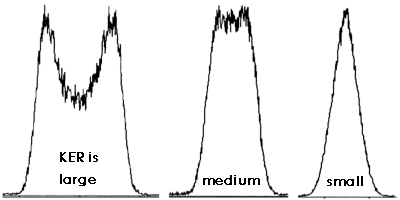a) What is the reason for the release of kinetic energy during unimolecular dissociations?
The total excess energy of a precursor ion relative to the heats of formation of the products in their ground state, comprises the excess energy in the transition state plus the activation energy of the reverse reaction.
Although most ion fragmentations are endothermic, there is still a significant amount of energy to be redistributed among the reaction products. Much of it is redistributed as vibrational energy. Nonetheless, some of the energy is converted into translational motion of the fragments relative to their center of gravity. This portion is released in the direction of the bond that is being cleaved, i.e., into diversion from each other. It is termed kinetic energy release (KER).
b) Assume the peaks shown below to appear at comparable E/E0 values in different MIKE spectra. Sort them in the order of the corresponding kinetic energy release (KER).

c) Which of these peaks can be expected to result from a homolytic bond cleavage or an ion-molecule complex-intermediated process?
The narrow Gaussian-shaped peak on the right because such reactions exhibit small KERs.